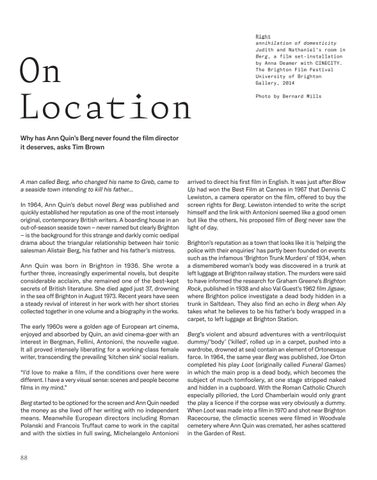On Location
Right annihilation of domesticity Judith and Nathaniel’s room in Berg, a film set-installation by Anna Deamer with CINECITY. The Brighton Film Festival University of Brighton Gallery, 2014 Photo by Bernard Mills
Why has Ann Quin’s Berg never found the film director it deserves, asks Tim Brown
A man called Berg, who changed his name to Greb, came to a seaside town intending to kill his father... In 1964, Ann Quin’s debut novel Berg was published and quickly established her reputation as one of the most intensely original, contemporary British writers. A boarding house in an out-of-season seaside town – never named but clearly Brighton – is the background for this strange and darkly comic oedipal drama about the triangular relationship between hair tonic salesman Alistair Berg, his father and his father’s mistress. Ann Quin was born in Brighton in 1936. She wrote a further three, increasingly experimental novels, but despite considerable acclaim, she remained one of the best-kept secrets of British literature. She died aged just 37, drowning in the sea off Brighton in August 1973. Recent years have seen a steady revival of interest in her work with her short stories collected together in one volume and a biography in the works. The early 1960s were a golden age of European art cinema, enjoyed and absorbed by Quin, an avid cinema-goer with an interest in Bergman, Fellini, Antonioni, the nouvelle vague. It all proved intensely liberating for a working-class female writer, transcending the prevailing ‘kitchen sink’ social realism. “I’d love to make a film, if the conditions over here were different. I have a very visual sense: scenes and people become films in my mind.” Berg started to be optioned for the screen and Ann Quin needed the money as she lived off her writing with no independent means. Meanwhile European directors including Roman Polanski and Francois Truffaut came to work in the capital and with the sixties in full swing, Michelangelo Antonioni
88
arrived to direct his first film in English. It was just after Blow Up had won the Best Film at Cannes in 1967 that Dennis C Lewiston, a camera operator on the film, offered to buy the screen rights for Berg. Lewiston intended to write the script himself and the link with Antonioni seemed like a good omen but like the others, his proposed film of Berg never saw the light of day. Brighton’s reputation as a town that looks like it is ‘helping the police with their enquiries’ has partly been founded on events such as the infamous ‘Brighton Trunk Murders’ of 1934, when a dismembered woman’s body was discovered in a trunk at left luggage at Brighton railway station. The murders were said to have informed the research for Graham Greene’s Brighton Rock, published in 1938 and also Val Guest’s 1962 film Jigsaw, where Brighton police investigate a dead body hidden in a trunk in Saltdean. They also find an echo in Berg when Aly takes what he believes to be his father’s body wrapped in a carpet, to left luggage at Brighton Station. Berg’s violent and absurd adventures with a ventriloquist dummy/‘body’ (‘killed’, rolled up in a carpet, pushed into a wardrobe, drowned at sea) contain an element of Ortonesque farce. In 1964, the same year Berg was published, Joe Orton completed his play Loot (originally called Funeral Games) in which the main prop is a dead body, which becomes the subject of much tomfoolery, at one stage stripped naked and hidden in a cupboard. With the Roman Catholic Church especially pilloried, the Lord Chamberlain would only grant the play a licence if the corpse was very obviously a dummy. When Loot was made into a film in 1970 and shot near Brighton Racecourse, the climactic scenes were filmed in Woodvale cemetery where Ann Quin was cremated, her ashes scattered in the Garden of Rest.













